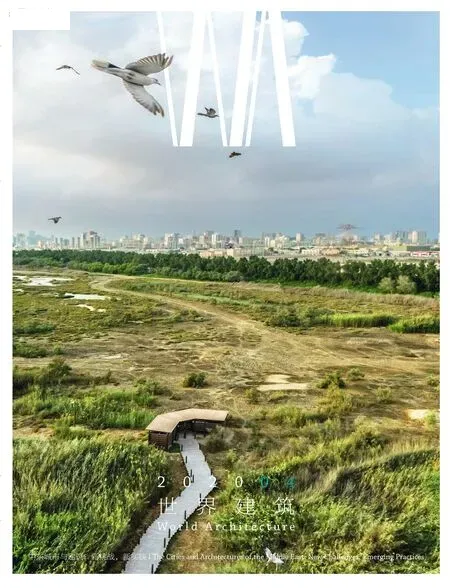建筑学边缘的实践
加扎勒·阿巴西-阿斯巴格/Ghazal Abbasy-Asbagh
尚晋 译/Translated by SHANG Jin
论点
[贝鲁特]加扎勒:
“你们实践的定位是什么?”
[贝鲁特]拉法特:
“我工作的一大关注点是将‘虚构’作为一种逻辑体系来运用,而非囿于虚构与非虚构的二元对立。在这个意义上,虚构让我在以建造(既是文字上的,也是当代艺术中的)世界作为建筑的实践中,创造出替代文本及‘其他’场景的世界/运动场。”
[ 德黑兰 ] 纳希德:
“德黑兰城市创新中心(TUIC)成立于2016年。其目标是在全球城市创新的整个网络中,通过在知识生产模式2的框架内知识的生产、交流和施用来创造价值。我们认为教学作为建筑话语、研究和实践的持续性调节手段,需要在多重性的状态下去分析,所以并非仅仅局限于官方学术机构框架的构成要素。”
[贝鲁特]萨利姆:
“我只是把它称作建筑,其他的一切都是服务。我提供足以支付房租的服务,并且尝试去做越来越少的工作,其余的才是建筑。”
[德黑兰]礼萨:
“美存在于利益相关者的眼中。”
“要通过分析需要得到解答的根本问题,是与建筑项目相关的问题与GDP驱动思维之间的本质关系。因此,所采纳的是一种以在空间创造中寻求恰当的建筑解决方案的过程为先、而以这一过程的最终结果或空间产物为后的世界观。”
推论
建筑先后在康德的先验和福柯的认知意义上,奠定了使知识、话语和文化的创造成为可能的条件基础。大致考察一下本期展示的上述建筑师的作品,就会看到一种让环境超越“建成表达”的愿望。如此一来,这些建筑师首要的挑战就是,相对于积极地利用环境背景,从“将建筑作为建造的可识别符号的构造愿景”1)[1]角度去设计他们的实践,并给自身定位。这样的话,一个难以回答的问题仍十分明显:什么是建筑?或者说,建筑的实践需要什么?对于一个数十年来话语都由自主和历史意识的问题来定义的学科——正是这些问题导致了对现代主义的批判反思——这种转变(假如我们可以这样叫它)很可能是健康的,如果不是不可避免的。今天正在兴起的各种实践,包括在中东的那些,都不得不构想出一种全新的实践模式,并在一个与前几代人截然不同的领域经营下去。
在一篇1968 年的文章中,汉斯·霍莱因直言道:“一切皆建筑。”2)[2]霍莱因认为传统的建筑定义是有局限的,而且丧失了效力;环境作为一个整体才是建筑活动的领域。他提出人会从空间上和心理上拓展自身的领域,并由此决定了最广义的“环境”。这样,通过身心的拓展,人就“进行了沟通”,而建筑是这种沟通的介质。尽管1968 年的确是全球动荡的一年,并且那个10 年是“反文化”的10年,霍莱因的论述却毫无新意可言。它只是扩充一下了雨果的话:“在世界的前6000 年中,建筑一直是人类的伟大手稿。”[3]304在小说《巴黎圣母院》第二章,雨果向他的女性读者道歉,“若是我们在此停歇片刻,并努力挖掘一下隐藏在领班神父谜一般的话语‘这将把它摧毁’背后的含义,那就是:书将把建筑摧毁。”[3]305在说“纸书”将摧毁“石头书”时,他确立了建筑作为沟通手段的作用,而它至今一直在为教会和国家效力[3]306。
“众贤治世接替独裁统治的历史刻在了建筑上。因为——在这里我们必须强调——决不能以为建筑只能带来神庙,只能表达僧侣的神话和象征,只能用象形文字将神秘的《十诫》誊写到它的石书上。倘若真的如此,那么——鉴于每个人类社会都会迎来一个神圣象征被废弃的时刻:自由的思想摧枯拉朽,人摆脱了神的仆役,哲学和制度的发展令宗教的面孔瓦解——建筑将无法重现人类思维的这个新阶段:它的书页正面有记载,而背面将一片空白;章节会被删减;而建筑的巨著也将残缺不全。然而并非如此……”(《巴黎圣母院》,维克多·雨果,1831)[3]308
如果我们承认建筑是一种沟通的工具,并且在一个大繁荣时期[4]的乐观及其与环境往往是有害的关系早已过去的时刻,面对全球错综复杂的社会经济和政治挑战,它能够创造知识、话语和文化,那么问题就是:在为全球规模的自由市场贸易服务之外,建筑服务的又是什么?而这是否构成了学科范式转变的基础?本文将通过在两座中东城市的新兴建筑实践之间建立对话,尝试回应这些问题。
双城记
“我们曾拥有一切,我们却两手空空,我们本要直升天堂,我们却直入地狱——简而言之,那个时代恰如现在,以至于最喧闹的权威也坚持认为只能用最高级去描述它,不论这样是好是坏。”(《双城记》,查尔斯·狄更斯, 1859)[5]
这两座城市就是德黑兰与贝鲁特。时间是2019年,全球风云变幻的一年。虽然德黑兰与贝鲁特的大小、人口、地理、政治、经济和城市形态均不同,却都是冲突和动乱频频。这两座城市都缺少基本服务设施,污染极其严重,交通拥堵;社会经济分化体现在日常生活的方方面面。
或许今天贝鲁特处于一种典型的新自由主义状态,瘫痪的公共部门完全无法提供基本服务3)[6]。在这个海滨小国的首都,内部宗教和派系对立造成的冲突由于其地缘政治状况而加剧——它处在一系列相互冲突的区域性和全球性的意识形态、政治和政策潮流的要冲。
在伊朗1979 年革命的40 年后,德黑兰从山区到沙漠一共住着1200 多万人。这座城市以天文数字的速度增长,人口从350 万增长到1200 万只用了不到20 年,而几乎没有任何政府部门的监管。一国之都与世隔绝近40 年。每次政治转折都使德黑兰坠入绝望的深渊,并体现在经济的衰败上。由这些状况导致的社会经济分化表现在两座城市许许多多不堪言说的离奇的阶级差异上。
建筑恰好可以解决这些问题,但同时又受到程序和机制的阻碍,而这长久以来一直限制了它在塑造建成环境中发挥核心作用的能力。今天在这种环境中行进的新兴实践,面对因全球资本流和相互冲突的地缘政治潮流而加剧的愈发严酷的社会经济状况,不得不在与前几代人截然不同的领域中构想出一种全新的实践和经营模式。
成果4)
下面是一个短篇小说、一座建筑、一个建筑教学机构和一条阿拉伯头巾5)。虽然这些项目之间以及同“建筑作为建造的可识别符号”概念的关联很弱,但选出的这些项目意在建立一个更宽泛的实践范围,使建筑再度成为一种沟通的工具。面对一个完全被自由贸易和市场力量驱动的世界秩序,建筑具有了意识形态的属性。因此建筑是一种抵抗的手段、一种创造韧性的途径,能够在学识的塑造中再度占领它的位置。
拉法特·马吉祖卜
“对于祖母,每个人都是一个宇宙中的宇宙,其他的每个人和每样东西都活在那里面。……在她的宇宙中,一切都需要大胆的信仰之跃。现实并没有真的被分享或表达出来。”
上面的引文出自《洒了香水的花园》。马吉祖卜将它作为一个短篇小说发表在《前哨》杂志上6)[7]。这段文字成为“他对另类政治的不懈追求、重写永续小说以及研究新形式社会结构的骨架。”[8]因此这座花园成了一个新的领域,它邀请读者来到“一个可延展的神秘版的阿拉伯世界,这正在被新一代人的爱和反叛不断雕琢。”[8]可以说,这种实践模式相对于“社会图示”与空间建构的反馈环,能把前一种介质直接转译为后者。
Tractate
[Beirut] Ghazal:
"Where do you locate your practice?"
[Beirut] Raafat:
"Major focus of my work is the use of 'fiction'as a logical system, rather than within the fiction vs.non-fiction binary.In that sense, fictions allow me to create worlds / playing fields to text alternative and 'other' scenarios within a process of worldbuilding (both textual and within contemporary art)as architecture."
[Tehran] Nashid:
"Established in 2016 Tehran Urban Innovation Centre (TUIC) aims at creating value across the global network of urban innovation, through producing, exchanging and implementing knowledge within the framework of mode-2 knowledge production.We argue that pedagogy, as a constant moderator of discourse, research and practice, needs to be analysed in a state of multiplicity and thus not just limited to what constitutes the frameworks of official academic institutions."
[Beirut] Salim:
"I just call it architecture, everything else is service.I do enough service to pay the rent and I try to do less and less of it, the rest is architecture."
[Tehran] Reza:
"Beauty is in the eyes of the stakeholder.
The fundamental question to which an analytical response is to be sought, is the substantial relationship between the issues pertaining to an architectural project and a GDP-driven mentality.As such, a world view that prioritises the process of finding a proper architecture solution in spatial production over the end result of the process or the spatial product, is adopted."
Conjecture
Architecture, first in the Kantian apriori and later in the Foucauldian epistemic sense, sets the ground for the condition of possibility of the production of knowledge, discourse, and culture.A brief survey of the work of the architects quoted above and presented herein reveals a desire to engage the environment beyond the "built statement".In doing so, the first and foremost challenge of these architects is designing their practice and positioning themselves in respect to the "tectonic vision of architecture as the legible sign of construction"1)[1]vis-à-vis actively engaging their context.As such, the difficult question remains the obvious one: What is architecture? Or rather,what does the practice of architecture entail? For a discipline whose discourse has for decades been defined by the questions of autonomy and historical consciousness - amounting to critical reflections on modernism - this shift, if we may call it that, is quite possibly healthy, if not inevitable.The emerging practices of today, including those in the Middle East, are forced to envision an entirely new mode of practice and operate in an entirely different domain than the generations that came before them.
In a 1968 essay, Hans Hollein claimed simply:"Everything is Architecture."2)[2]Hollein suggests that traditional definitions of architecture are limited and have lost their validity and that the environment as a whole is the domain of the activity of architecture.He posits that one physically and psychically expands his or her sphere and in doing so determines "environment"in its widest sense.As such, through the expansion of body and mind s/he "communicates", and architecture is the medium of this communication.While 1968 was indeed the year of global revolts and the decade was that of "counterculture,"Hollein's statement was hardly a new one.It was a mere expansion of Hugo's claim that "during the first six thousand years of the world, architecture has been the great manuscript of the human race."[3]304In the second chapter of the novel Hunchback of Notre dame Hugo apologises to his "lady readers … if we halt a moment here and endeavor to unearth the idea hidden under the Archdeacon's enigmatical words: This will destroy That.The Book will destroy the Edifice."[3]305In stating that the "book of paper"will destroy the "book of stone," he establishes the agency of architecture as a tool of communication,one that had thus far been in the service of the church and state[3]306.
"The reign of many masters succeeding the reign of one is written in architecture.For - and this point we must emphasise - it must not be supposed that it is only capable of building temples, of expressing only the sacerdotal myth and symbolism,of transcribing in hieroglyphics on its stone pages the mysterious Tables of the Law.Were this the case, then - seeing that in every human society there comes a moment when the sacred symbol is worn out, and is obliterated by the free thought,when the man breaks away from the priest, when the growth of philosophies and systems eats away the face of religion - architecture would be unable to reproduce this new phase of the human mind: its leaves, written upon the right side, would be blank on the reverse; its work would be cut short; its book incomplete.But that is not the case…"(Victor Hugo,Hunchback of Notredame, 1831)[3]308
If we accept architecture as a tool of communication and its capacity in production of knowledge, discourse,and culture, at a moment well beyond the optimism of the boom era[4]and its often toxic relationship with the environment, facing a plethora of socio-economic and political challenges across the globe, the question is: what is architecture in service of but that of the fee market trade at a global scale? And does this constitute the grounds for a paradigm shift in the discipline? In this paper I seek to respond to these questions by creating a dialogue between emergent architectural practices in two Middle Eastern cities.
The Tale of Two Cities
"We had everything before us, we had nothing before us, we were all going direct to Heaven, we were all going direct the other way— in short, the period was so far like the present period, that some of its noisiest authorities insisted on its being received, for good or for evil, in the superlative degree of comparison only." (Charles Dickens, A Tale of Two Cities, 1859)[5]
The two cities are Tehran and Beirut.The year is 2019, the year of global revolt.While Tehran and Beirut have their differences in size, population,geography, politics, economy, and urban form, they both have had their fair share of conflict and upheaval.Both cities suffer from a lack of basic services, extreme pollution, congestion, and a socio-economic divide that manifests itself in all aspects of daily life.
可汗:阿拉伯文化实践原型协会
马吉祖卜写道,“在写《洒了香水的花园》的整个过程中逐渐发现,这‘另一个’构建出来的世界需要一个支配的力量、一个组织的实体。因此,可汗协会诞生了。”[9]随后他将可汗协会注册为黎巴嫩的非政府组织,正式名称为“可汗:阿拉伯文化实践原型协会”。可汗协会在本质上是要将小说激活,使之成为建筑延伸活动的场所;城市规模的项目及政策研究等都植根于作为建筑的写作活动,从而建立起文字与其他活动之间的反馈环:
“可汗协会在麻省理工学院和拉文施泰因大厦的酒店房间都出自《洒了香水的花园》小说中的房间,它还被临时嫁接到其他小说中。布鲁塞尔的可汗协会是可汗空间的第二次重现,成为一次奢华入侵的时段性表演。它漂浮在以一种特殊的地位存于当世的戏谑、严肃和攻击性的调子之间——去目睹清醒的死亡、移民、排外性立法、联盟的崩溃和对现下假象的幻灭。”
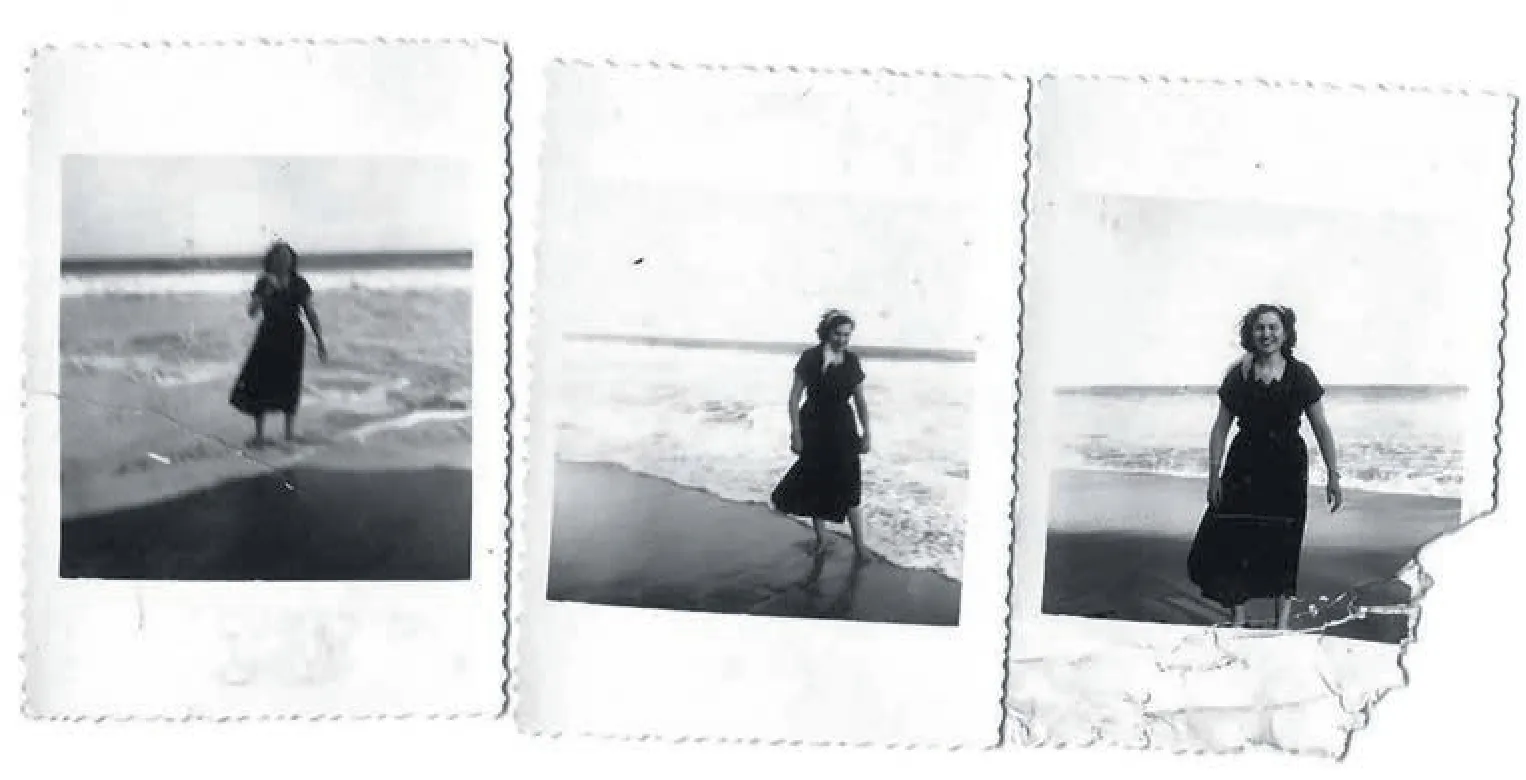
1《洒了香水的花园》中图/Image from The Perfumed Garden(图片提供/Courtesy of The Khan)
德黑兰城市创新中心(纳希德·纳比安)
纳比安成立德黑兰城市创新中心的决定在本质上是一个草根运动。它源于一种认识——学术体系是有缺陷的,无法应对极其复杂的城市状况,并且繁杂的社会经济因素又使之雪上加霜。它通过寻找工业区或低收入街区等被忽视的城市区来实现这一点。城市生活的数字化层面被作为空间设计的一个新领域[10]。另一个同样启迪思想的例子是“探头座”。据设计师说,“探头座的关注点是将各种材料、技术和制造技术融合起来去实现一种混合效果,从而拓宽了软机器人技术的可能性。”[10]
萨利姆·阿勒卡迪
或许最能代表阿勒卡迪作品特点的是一种出奇的清晰,这体现在对极端复杂条件的简单而巧妙的回应上。阿勒卡迪冷淡的态度和对作品低调的表现是一系列本来很复杂的运行模式的症状。这些运行模式体现在一个强有力而又平凡的物体上,它拥有冲破文化界限和颠覆社会准则的潜能。
“K29阿拉伯头巾002号
时间:2017年
材料/介质:对位芳纶合成纤维(K29芳纶®);配棉线十字绣。
尺寸:1200mm×1200mm
这个项目探索了将芳纶®作为一种防弹和类似飞弹的强力材料的潜力。这段芳纶®从美国偷偷运到黎巴嫩后,被送到位于赛达的艾因赫勒韦难民营的一位妇女家中。随后她在指导下把这种传统图案绣在织物上,并选择了十字绣来保护芳纶纤维的结构完整性。
这种阿拉伯头巾裹在头上后,它的性能由于材料的层叠和编织的多向性得到了提高。在实现这一点的同时,它又在战场和/或公共空间中延续了一种普遍的象征意义。从形象上看,戴着这个头巾的人犹如我们都渴望成为的神奇的超级英雄。”[11]
“贝鲁特001号
时间:2019年
材料/介质:贝鲁特的犀牛5.0软件制作的3dm格式3D模型
大小:697 MB
在环境、经济和政治的大灾难中,我的贝鲁特理发师抱怨说:
“(他们)不让你活(他们)也不让你死……”
在这个永不得超脱的炼狱里,当建筑成为一种令人作呕的暴行时,建筑师要做什么?
当需求——并非渴望——遭到贬抑时,我们还能冒险去相信建筑会成为一剂解药吗?我们还能在自己创造出来的亮丽光鲜中安居吗?我们还能天真地幻想没有叛逆的变革吗?还是说叛逆足以催生变革?
贝鲁特001号是第一个直接可用的贝鲁特3D数字模型。
模型标示出了建筑、道路、桥梁和隧道,并利用建筑师及其团队可用的简单方法耗时3年建成。它为今天的公众提供了一同重新想象我们城市的基本手段。
我们将用它做什么呢?
环保主义者会用它来模拟城市中的微风场类型,并提出新的电力配给方案,以降低非正规电网造成的空气污染吗?
激进分子会标示出城市中为发现潜在的抗议场所而非法安装的2000个闭路电视摄像头吗?
或者,制图人员会把长期禁止公开的城市信息嵌入图层吗?
它足够精确吗?还是说测绘员应该把它做得更准确,然后再次分享?
……
你会拿它做什么呢?”
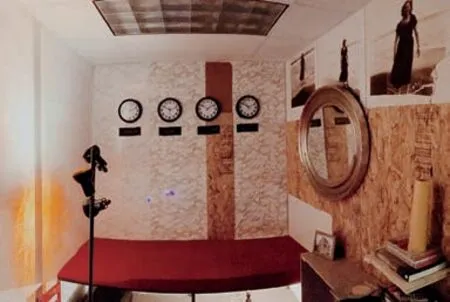
2可汗酒店,波士顿/The Khan Hotel, Boston(图片提供/Courtesy of The Khan)
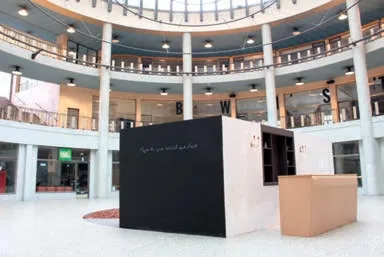
3可汗酒店,布鲁塞尔/The Khan Hotel, Brussels(图片提供/Courtesy of The Khan)
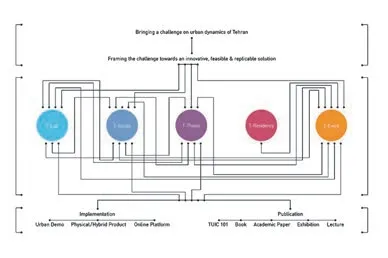
4德黑兰城市创新中心组织图/Tehran Urban Innovation Center Organisation Chart(图片提供/Courtesy of TUIC)
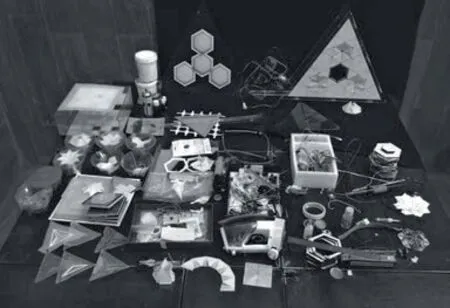
5探头座/Poking Seat(图片提供/Courtesy of TUIC)
Perhaps what characterises Beirut today is an intensely neoliberal condition, in which a paralysed public sector is completely ineffective in providing basic services3)[6].The capital of a small coastal country, the strife created by its internal religious and sectarian divide is exacerbated by its geopolitical condition at the crossroads of a range of regional and global streams of conflicting ideologies,politics, and policies.
Four decades after Iran's 1979 Revolution, Tehran houses over twelve million people stretching from the mountains to the desert.The city has grown at an astronomical rate that took the population from 3.5 million to twelve in less than two decades with minimal oversight from any governing bodies.The capital of a country closed off to the world for nearly four decades,Tehran plummets to despair with every political turn,which finds its manifestation in a failing economy.The socio-economic divide created by these conditions is manifested in a range of uncanny class disparities in both cities that are simply unspeakable.
Architecture finds itself distinctly equipped to address these issues and simultaneously obstructed by procedures and mechanisms that have long limited its capacity to play a central role in shaping the built environment.Operating within these environments, in increasingly grim socio-economic conditions, exacerbated by global flows of capital and conflicting geo-political streams, the emerging practices of today are forced to envision an entirely new mode of practice and operate in an entirely different domain than the generations before them.
Yield4)
Included herein are a novella, a building, an institute for teaching architecture, and a Keffiyeh5).While the connection between these projects and to the notion of "architecture as a legible sign of construction" is tenuous, the range of the projects selected is intended to establish a broadened domain of practice, in which architecture becomes once more a tool for communication.Facing a world order entirely driven by free trade and market forces architecture becomes ideological.Architecture is thus a tool for resistance, for developing resilience, capable of occupying its place once more in shaping the episteme.
Raafat Majzoub
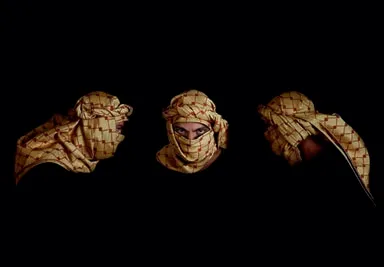
6K29阿拉伯头巾002号/K29 Keffiyeh 002(摄影/Photo:Marwa Younis)
"To my grandmother, every man is a universe within a universe where every other man and thing lives.[…] In her universe, everything required a bold leap of faith.Reality was not factually shared or communicated."
The quotation above is from "The Perfumed Garden".Majzoub published it in The Outpost Magazine6)[7]as a novella.The text became a"skeleton for an ongoing pursuit of alternative politics, rewriting sustainable fictions, and researching new forms of social architecture."[8]The Garden thus became a new territory; one that invites the reader to "a malleable and mysterious version of the Arab World that is being sculpted by the loves and revolts of a new generation."[8]This mode of practice arguably allows a direct translation of "social diagrams" into spatial constructs vis-à-vis a feedback loop that engages both mediums.
The Khan: The Arab Association for Prototyping Cultural Practices
Majzoub writes that "throughout the process of writing The Perfumed Garden, it became clear that this 'other' constructed world would need a governing force, an entity of organisation.For that reason, The Khan was born."[9]He then proceeded to register the Khan as an NGO in Lebanon by the official name "The Khan: The Arab Association for Prototyping Cultural Practices".The Khan in essence is the activation of fiction as a venue for further acts of architecture; urban scale projects, policy research,etc.all rooted in the act of writing as architecture,thus creating a feedback loop between the text and other activities:
"The Khan's hotel rooms at the Massachusetts Institute of Technology and Galerie Ravenstein are rooms from The Perfumed Garden's fiction that are temporarily grafted in other fictions.The Khan in Brussels is the second iteration of The Khan spaces,which functioned as a durational performance of luxurious intrusion, floating between the playful,serious and offensive tonalities of being present in the world today as an observer of lucid death,migration, xenophobic legislation, the crumbling of unions and disillusionment with present fictions."
Tehran Urban Innovation Centre (Nashid Nabian)
Nabian's decision to establish the Tehran Urban Innovation Centre is in essence a grass-roots movement that hinges on recognising the deficiencies of an academic system that is unable to respond to an extremely complex urban condition, exacerbated by a multitude of socio-economic factors.It does so by identifying neglected urban zones such as industrial zones or low-income neighbourhoods.The digital layer of urban life is utilised as a new realm for spatial design[10].Another, equally thought-provoking example is the Poking Seat.According to the designers, "The Poking seat expands of possibilities of soft robotics with a focus on merging various material, technical, and fabrication technologies to achieve a hybrid effect."[10]
Salim Al Kadi
Perhaps what most represents Al Kadi's work is the uncanny clarity of a simple yet cunning response to an extremely complex condition.Al Kadi's nonchalant attitude and understated representation of the work is a symptom of an otherwise sophisticated series of operations that manifest themselves in an object so potent, yet so mundane that has the potential to trespass cultural boundaries and subvert social norms.
"K29 Keffiyeh 002
Date: 2017
Materials/Medium: Para-aramid synthetic fiber(K29 Kevlar®); with cotton-thread embroidery in cross-stitch.
Dimensions: 1200mm × 1200mm
This project explores the potential of Kevlar®as a powerful material used to resist bullets and similar flying projectiles.Having been smuggled into Lebanon from the US, the length of Kevlar®was then delivered into the home of a woman in the Ain al-Hilweh Refugee Camp in Saida, who was instructed to embroider this traditional pattern upon the textile, a cross-stitch chosen to preserve the structural integrity of the Kevlar fibres.
Wrapping it around one's head, the Keffiyeh's performance is increased through the layering of material and the multi-directionality of the weave.It does so while maintaining an omnipresent symbolism upon the battlefield and/or in public space.In images,those who wear the Keffiyeh appear as fantastic superheroes we all aspire to be."[11]
"Beirut 001
Date: 2019
Materials/Medium: 3D model of Beirut in 3dm Rhinoceros 5.0 format.
Size: 697 MB
In the midst of an environmental, economic, and political catastrophe, my barber in Beirut complains:
"(They) don't let you live and (they) don't let you die…"
In this state of eternal purgatory what will architects do, when building is a nauseatingly violent act?
When need - not desire - is trivialised, can we still risk believing architecture to be part of the solution?Can we continue to obediently inhabit the pristine renders we produce? Can we still naively imagine change without disobedience? Or that disobedience is enough to bring about change?
ZAV(穆罕默德·礼萨·戈杜西)
德黑兰拥挤的城市中心的一家工作室被分成许多工作间,一个个项目在其中穿梭——从一步到另一步——这个过程就像工厂里的生产线。戈杜西直言不讳的那句“美存在于利益相关者的眼中”无异于一个口号。对于一家力图直面严峻社会经济状况的建筑工作室,这就是其宣言书的纲领。
下面这些文字被打印出来,贴在每个“工作间”的门口:
“ZAV是一个由类型驱动的事务所
现有的类型能够满足我们所有的空间需求和渴望吗?还是说应该去创造新的类型?新创造的类型应当在面对多种多样的需求和未来不可预见的情况时表现出韧性。
ZAV是应变的(也是灵活的)
审美是追求创造增加值的心理状态的产物,因此没有先天的定义。美要由观察者来判断,要么是残缺、不一致的格调,要么是表示庄严和完美的。
ZAV是脚踏实地的
建筑可以通过价值的创造,甚至是在实现国家利益这样的共同利益时满足个体利益的方式变得丰满……我们关于促进共同利益实现的标准是:用建筑作为一种动力来提高国内生产总值(GDP)。
ZAV支持手工艺
施工技术和手工艺是至关重要的,因为国内拥有充足的人力资源,而且能从这种对工作优先级的重新评估中获益。这样GDP提高了,而灵活、经济的施工技术以及地方的企业家都会集中在与建筑和创造空间有关的事上。”[12]
亮相霍尔木兹[13]:冲突、色彩与可持续
项目位于霍尔木兹南部,通过为岛上本地居民赋能的自下而上的过程,完成了构思、设计和制造。这个原型的设计和建造是以建筑师纳迪尔·哈利利的超级土坯房试验为基础的。这种施工材料/过程几乎无需获取知识,并且使用的是岛上清淤出来的资源。
法尔希电影工作室和艾塔姆织毯厂
这两个项目——一个是原有住宅的翻新,另一个是新建项目——相互之间有一种直接的对话。因为二者都从材料的逻辑中找到了美学线索,而这在意识上是由推动本地经济的愿望驱动的。
后记
索莫尔认为,在我们使建筑的作用超越“建造的可识别符号”之时,建筑的任务就成为对社会图示的转译。本文介绍的新兴实践的意义在于以建筑实践作为社会政治和文化问题的直接回应。他们赋予自己的使命不只是阐释和转译社会图示,还要定义这些图示。这样,他们赋予建筑的责任远远超越了之前的先锋派,并在建成环境的塑造中占据了大得多的空间,尽管他们并不一定要积极参与建筑的构造性活动。□

7 贝鲁特001号/Beirut 001(图片提供/Courtesy of Salim Al Kadi)
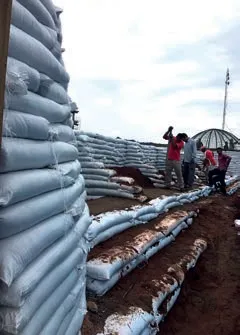

8.9 亮相霍尔木兹/Presence in Hormoz(图片提供/Courtesy of Majara Accommodations)

10 法尔希电影工作室/Farsh Film(摄影/Photo: Soroush Majidi)
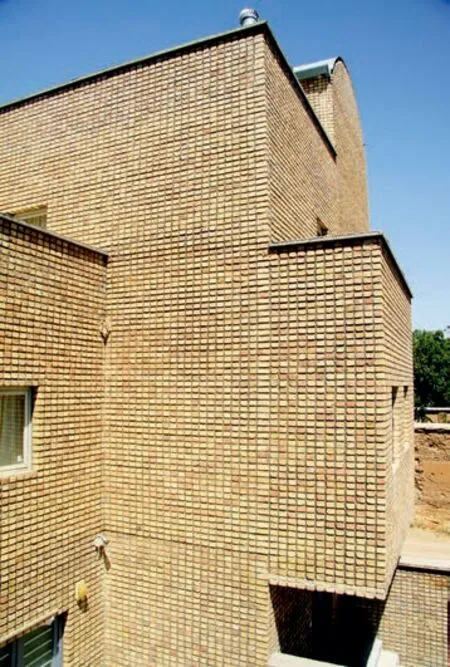
11 艾塔姆织毯厂/Aytam Carpet Weavers(摄影/Photo:Soroush Majidi)
Beirut 001 is the first readily available digital 3D model of Beirut.
Mapping buildings, roads, bridges, and tunnels,and constructed with the humble means available to the architect and his team over the span of three years,it is offered to the public today as a preliminary tool to collectively re-imagine our city.
What will we do with it?
Will environmentalists use it to simulate micro wind patterns in the city and suggest new electricity rationing schedules to reduce air pollution from the informal power grid?
Will activists map the 2000 CCTV cameras illegally installed in the city to find a potent space of protest?
Or will cartographers inscribe into layers longforbidden urban information?
Is it precise enough? Or should surveyors make it more accurate and share it again?
…
What will you do with it?"
ZAV (Mohammad Reza Ghodoussi)
In a studio located in Tehran's overcrowded city centre compartmentalised into several operation rooms, projects move from room to room - operation to operation - in a process akin to a fabrication line in a factory.Ghodoussi's unapologetic statement"beauty is in the eyes of the stakeholder," is nothing short of a slogan that crystalises a manifesto for an architectural practice that is intent on assertively engaging a dire socio-economic condition.
The following statements are printed and installed at the entry to each "operation room":
"ZAV is a Typologically Driven Practice
Are the existing typologies capable of meeting all our spatial needs and desires, or, should new typologies be invented? The invented types should be the ones that can act resilient in confronting variegated needs and unpredictable future circumstances.
ZAV is Adoptive [and Agile]
Aesthetics are the result of a mentality that is oriented towards production of added value and as such does not have a priori definition.Beauty is to be identified by the beholder, either as incomplete,incoherent decors, or that which signals sublimity and perfection.
ZAV is Practical
Architecture can be informed by creating value and even how individual interests can be satisfied along with achieving common good, i.e.national interest(s)…Our criteria for further deliverance of common good, is improvement of Gross Domestic Product (GDP) with architecture as an actant in this dynamism.
ZAV Embraces Craftsmanship
Construction technology and craftsmanship is of utmost importance, given the abundance of available human resources in the country that can benefit from such re-evaluation of priorities.As such, GDP is improved and agile, economical technologies of construction, as well as local entrepreneurship gain a central focus in matters pertaining to architecture and production of space."[12]
Presence in Hormoz[13]: The Conflictual, the Colourful, and the Sustainable
Located in the Southern province of Hormoz,this project is conceived, designed, and fabricated through bottom-up processes that empower the island's local population.The prototype is designed and constructed based on Architect Nader Khalili's experiment with Super-adobe, a construction material/process that requires very little acquired knowledge and uses resources of the Island grabbed from dredging.
Farsh Film Studio and Aytam Carpet Weavers
The two projects - one the restoration of an existing house, the other a ground-up project - are in direct dialogue with one another, as they both take their aesthetic clues from their material logic,which is ideologically driven by a desire to advance local economy.
Post Script
Somol argues that in a moment that we allow the role of architecture to be expanded beyond "the legible sign of construction", the task of architecture becomes that of translating social diagrams.The significance of the emerging practices featured in this paper is that by engaging in practice of architecture as a direct response to socio-political and cultural issues.They task themselves with more than only interpreting and translating social diagram, but rather defining these diagrams.As such, they expand the task of architecture far beyond that of the avant-gardes that came before them and occupy a much greater space in shaping the built environment, despite the fact that they do not necessarily always actively partake in the tectonic act of architecture.□
注释/Notes
1)索莫尔将建筑师的作用从维特鲁威的“庄严”概念拓展到“转译社会图示”上——对比福柯关于机器的社会属性先于技术属性的概念。见参考文献[1]。/Somol expands the role of the architect beyond the Vitruvian notion of "gravitas", to that of"translating social diagrams" vis-à-vis the Foucauldian notion of machines being social before being technical.See Reference [1].
2)这篇文章以《一切皆建筑》为题,用英文发表于参考文献[2]。/The essay is published in English as"Everything is Architecture." in Reference [2].
3)关于新自由主义城市政策对当代中东城市的塑造,请见参考文献[6]。/For the neoliberal urban policies shaping contemporary Middle Eastern cities,see Reference [6].
4)换言之,本文阐述的过程的产物。/In other words, the product of the process elaborated on herein.
5)阿拉伯世界里男子戴的围巾,已经成为巴勒斯坦抵抗组织的代表物。/A scarf worn by men in the Arab world that has become representative of the Palestinian resistance.
6)《前哨》是一部潜力无限的黎巴嫩杂志,一年两期,见参考文献[7]。/The Outpost is a magazine of possibilities published twice a year in Lebanon.See Reference [7].
参考文献/References
[1] SOMOL R E.The Diagrams of Matter[J]//Diagram Works: Data Mechanics for a Topological Age.Architecture New York, 1998 (23): 23-26.
[2] OCKMAN J, EDWARD E.Architecture Culture,1943-1968: A Documentary Anthology[C].New York:Columbia University, Graduate School of Architecture,Planning, and Preservation, 1993.
[3] HUGO V.Volume 1, Book five, Chapter 2[M]//The Hunchback of Notre Dame, 1831.
[4] STIGLITZ J.The Roaring Nineties[J/OL].The Atlantic, 2002.https://www.theatlantic.com/magazine/archive/2002/10/the-roaringnineties/302604/.
[5] DICKENS C.A Tale of Two Cities[M].1859.
[6] DAHER R F.Uneven Geographies and Neoliberal Urban Transformation in Arab Cities Today[J].International Journal of Islamic Architecture, 2008, 7(1): 29-35.
[7] Folch Studio.The Outpost[J/OL].https://www.folchstudio.com/the-outpost/.
[8] MAJZOUB R.The Perfumed Garden[M/OL].https://www.raafatmajzoub.com/the-perfumedgarden.
[9] MAJZOUB R.Writing as Architecture: Performing Reality until Reality Complies[J].Anti Atlas Journal,2017 (2).
[10] Tehran Urban Innovation Center[EB/OL].http://www.tuic.ir/en/.
[11] AL-KADI S."K29 Keffiyeh 002" [EB/OL].http://www.salimalkadi.com/keffiyeh002.
[12] ZAV Architects [EB/OL].http://www.zavarchitect.com/.
[13] ZAV Architects.Presence in Hormoz | Rong Cultural Center[EB/OL].http://www.zavarchitect.com/?work=presence-in-hormoz-rong-cultural-center.
[14] AL-KADI S."Ghost Building" [EB/OL].http://www.salimalkadi.com/06_ghost-building.

